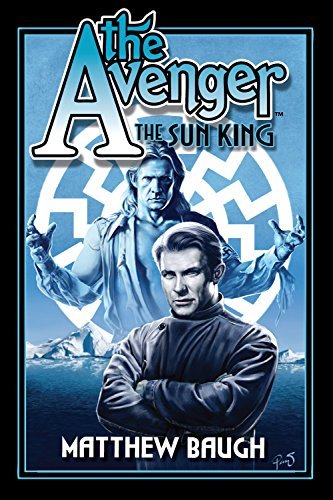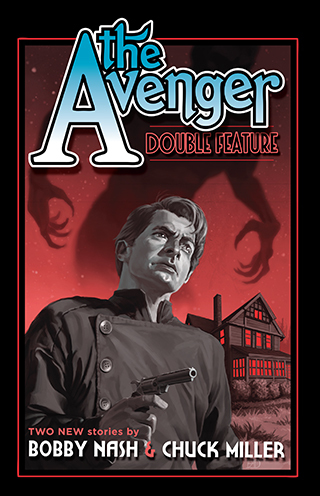


Books in series

Justice, Inc.
1939

The Yellow Hoard
1939

The Sky Walker
1939

The Devil's Horns
1972

The Frosted Death
1972

The Blood Ring
1972

Stockholders in Death
1940

The Glass Mountain
1973

Tuned For Murder
1940

The Smiling Dogs
1940

River of Ice
1973

The Flame Breathers
1973

Murder On Wheels
1973

Three Gold Crowns
1973

House of Death
1973

The Hate Master
1973

Nevlo
1973

Death in Slow Motion
1973

Pictures of Death
1973

The Green Killer
1941

The Happy Killers
1974

The Black Death
1942

The Wilder Curse
1974

Midnight Murder
1974

The Man From Atlantis
1974

Red Moon
1974

The Purple Zombie
1974

Dr. Time
1974

The Nightwitch Devil
1974

Black Chariots
1974

The Cartoon Crimes
1974

The Death Machine
1975

The Blood Countess
1975

The Glass Man
1975

The Avenger #35
The Iron Skull
1975

The Avenger #36
Demon Island
1975

The Avenger Vol. 3
The Frosted Death & The Glass Mountain
1974

The Avenger Vol. 7
Murder on Wheels & The Three Gold Crowns
2012

The Avenger Vol. 9
Nevlo & Death in Slow Motion
2013

The Avenger Vol. 10
Pictures of Death & The Green Killer
2013

The Avenger
The Sun King
2015

The Avenger Double Feature
2018

The Avenger
Double Feature 2
2020
Authors
Paul Frederick Ernst was an American pulp fiction writer. He is best known as the author of the original 24 "Avenger" novels, published by Street & Smith under the house name Kenneth Robeson. He "[took] up fiction writing in his early twenties." Credited by pulp-expert Don Hutchison as "a prolific manufacturer of potboilers-made-to-order," his stories appeared in a number of early Science fiction and fantasy magazines. His writing appeared in Astounding Stories, Strange Tales and Amazing, and he was the author of the Doctor Satan series which ran in Weird Tales from August, 1935. His most famous work was in writing the original 24 The Avenger stories in the eponymous magazine between 1939 and 1942. When pulp magazine work began to dry up, Ernst "was able to make a painless transition into the more prestigious "slick" magazines, where his word skill earned him higher financial rewards." As of 1971, he was "still active as a writer," including penning "Blackout" for the July 1971 issue of Good Housekeeping magazine. He died in Pinellas County, Florida. [https://en.m.wikipedia.org/wiki/Paul\_...] Librarian note: There is more than one author in the Goodreads database with this name. Paul^Ernst
Kenneth Robeson was the house name used by Street and Smith Publications as the author of their popular character Doc Savage and later The Avenger. Though most Doc Savage stories were written by the author Lester Dent, there were many others who contributed to the series, including: William G. Bogart Evelyn Coulson Harold A. Davis Lawrence Donovan Alan Hathway W. Ryerson Johnson Lester Dent is usually considered to be the creator of Doc Savage. In the 1990s Philip José Farmer wrote a new Doc Savage adventure, but it was published under his own name and not by Robeson. Will Murray has since taken up the pseudonym and continued writing Doc Savage books as Robeson. All 24 of the original stories featuring The Avenger were written by Paul Ernst, using the Robeson house name. In order to encourage sales Kenneth Robeson was credited on the cover of The Avenger magazine as "the creator of Doc Savage" even though Lester Dent had nothing to do with The Avenger series. In the 1970s, when the series was extended with 12 additional novels, Ron Goulart was hired to become Robeson.

Bobby Nash is an award-winning author, artist, and occasional actor. He writes novels, comic books & graphic novels, novellas, short stories, audio scripts, screenplays, and more. Bobby is a member of the International Association of Media Tie-in Writers, International Thriller Writers, and Southeastern Writers Association. From time to time, he appears in movies and TV shows, usually standing behind your favorite actor. Sometimes they let him speak. Scary, we know. For more information, please visit Bobby at www.bobbynash.com, www.ben-books.com, and across social media.

The Black Centipede and related characters are part of a grand concept I came up with myself and started writing and publishing on the web. They had actually been festering in my skull for more than 20 years—a proposed comic book that never made it off the ground—and it seemed about time to let them out. I realized I wasn't getting any younger. So I started cranking out prose like a man possessed. Well, the Black Centipede Press web project caught the eye of Tommy Hancock at Pro Se Press, and they have now published the first Black Centipede novel, "Creeping Dawn: The Rise of the Black Centipede." (Order it now from Amazon: http://www.amazon.com/Creeping-Dawn-R...) The Black Centipede is a traditional pulp action hero who refuses to behave like one. He casually breaks every rule in the book. Then he writes new rules. Then he breaks those. He is the world's greatest action hero. He is a dangerous madman. He is both criminal and crimefighter, pursuing an agenda that he himself has yet to fully define. His career has spanned 80 years (so far), and he has become involved with some of the most famous and infamous individuals of the 20th and 21st centuries. "Creeping Dawn" takes up his story in the pivotal period between 1927 and 1933. In his fictional world, the Centipede is both a real-life crime fighter and the star of a successful pulp adventure magazine, which presents highly-fictionalized accounts of his adventures. The series explores, among other things, the disparity between the public image and the man himself. We also learn the "shocking truth" about several well-known historical people and events. In the world of the Black Centipede, absolutely nothing is what it seems to be. THE CITY OF ZENITH, home of the Black Centipede, is a living example of the uncertainty principle. It is on the East or West Coast, or one of the Great Lakes, or the Mississippi River. Everyone has lived there at one time or another, including you. Zenith is one of the most versatile cities in the United States. It is as large or as small as it needs to be for whatever story I happen to be writing at a given time. I did not, however, discover it myself. The city was founded by Sinclair Lewis. According to WIKIPEDIA, "Winnemac is a fictional U.S. state invented by the writer Sinclair Lewis. His novel Babbitt takes place in Zenith, its largest city (population 361,000, according to a sketch-map Lewis made to guide his writing). Winnemac is also the setting for ‘Gideon Planish,’ ‘Arrowsmith,’ ‘Elmer Gantry,’ and ‘Dodsworth.’" Inspired by the work of the late Philip Jose Farmer, I have developed the habit of treating fictional characters as though they actually lived, and people who actually lived as though they were fictional characters. The Centipede has an elaborate history, for which I have created artifacts. Amelia Earhart, Frank Nitti, and William Randolph Hearst have prominent roles in the saga.

George Gross was born February 16, 1909 in Brooklyn. His parents, David and Serena Gross, were both young Jewish immigrants from the city of Szeged, Hungary. They married in 1908 and raised three children, George, his younger brother Arthur, and youngest sister, Beatrice. The family lived at 105 Bay 29th Street in Brooklyn. The father, David Gross, attended Pratt Institute and had a successful art career in the fashion industry. The father owned and operated a midtown art studio called Fashion Paper. One of his best clients was the popular Montgomery Wards mail order catalog. In June of 1927 George Gross graduated from high school. That fall he began to attend Pratt, as his father had before him. In June of 1931 George Gross graduated from Pratt. Even before graduation he worked for his father at Fashion Paper. He was soon joined by both of his younger siblings, Arthur and Beatrice Gross. The Gross family business provided George with a uniquely practical approach to commercial illustration. His first pulp cover assignments were for Mystery Novels Magazine and Double Action Western, which were produced by Winford Publications. George Gross next found work at Fiction House, where he became their top cover artist. He painted dozens of freelance pulp covers for Fiction House pulps, such as Action Stories, Air Stories, Baseball Stories, Complete Northwest, Detective Book Magazine, Fight Stories, Football Stories, Jungle Stories, North West Romances, and Wings. He also sold pulp covers to A. A. Wyn's Periodical House, for titles such as Ace Sports and Western Aces. In 1936 the father formed a new art agency, called the Nangro Ferrod Studios, at relocated to 15 West 38th Street in Manhattan. George Gross shared his studio space at this company with his brother and sister. He produced all of his pre-war pulp covers at this studio. His brother, Arthur Gross, drew pen and ink story illustrations for pulps produced by Fiction House, Popular Publications, Winford, and Ace Publications. In 1940 George Gross married his Dora Gross. She was born February 1, 1906 in NYC. The married couple moved to Flushing, Queens, and also bought a Summer home in Milford, Pennsylvania. They had one son. In 1942 George Gross reported to his draft board for induction in WWII. Although his age was thirty-three, he was disqualified from military service because of a lifelong serious impairment of vision in his right eye, which effected his depth perception and required corrective glasses. After the war George Gross began to sell freelance illustrations to paperback books from such publishers as Dell, Star Books, Lion Books, Bantam, Berkley Books, Cameo Books, and Ace Publications. In the 1950s George Gross shared an art studio with the illustrator, Mort Kunstler, on White Street in the Tribeca warehouse section of Lower Manhattan. In the 1960s he worked for men's adventure magazines, such as Male, Cavalcade, Action For Men, Argosy, Bluebook, Man's Conquest, Man's Illustrated, Man's World, Real, Saga, See, Stag, and True Adventures. On August 22, 1972 the wife of George Gross, Dora Gross, died at the age of sixty-six. In 1974 George Gross married his second wife, Gidget Gross. They moved to Rockaway, New Jersey. In the 1970s George Gross painted covers for The Avenger series of paperback books, published by Warner Paperbacks. In the 1980s he painted covers for the popular Nick Carter series of paperbacks for Ace Publications. According to the author Bill Cox, "George Gross could do exciting paintings even when there were no scantily clad damsels around, and what's more amazing, Fiction House let him!" George Gross died at age ninety-four on February 23, 2003.